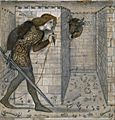Labyrinth facts for kids
The Labyrinth was an elaborate structure designed and built by the legendary Daedalus for King Minos of Crete at Knossos.
Its function was to hold the Minotaur, which was eventually killed by the hero Theseus. Daedalus had so cleverly made the Labyrinth that he could barely escape it after he built it.
Pliny's Natural History mentions four ancient labyrinths: the Cretan labyrinth, an Egyptian labyrinth, a Lemnian labyrinth, and an Italian labyrinth.
In English, the term labyrinth is generally synonymous with maze. As a result of the long history of unicursal representation of the mythological Labyrinth, however, many contemporary scholars and enthusiasts observe a distinction between the two. In this specialized usage maze refers to a complex branching multicursal puzzle with choices of path and direction, while a unicursal labyrinth has only a single path to the center. A labyrinth in this sense has an unambiguous route to the center and back and presents no navigational challenge.
Unicursal labyrinths appeared as designs on pottery or basketry, as body art, and in etchings on walls of caves or churches. The Romans created many primarily decorative unicursal designs on walls and floors in tile or mosaic. Many labyrinths set in floors or on the ground are large enough that the path can be walked. Unicursal patterns have been used historically both in group ritual and for private meditation, and are increasingly found for therapeutic use in hospitals and hospices.
Images for kids
-
Theseus in the Minotaur's labyrinth, by Edward Burne-Jones, 1861
-
Carving showing the warrior Abhimanyu entering the chakravyuha – Hoysaleswara temple, Halebidu, India
-
Chartres Cathedral, about 1750, Jean Baptiste Rigaud
-
Labyrinth on floor of Grace Cathedral, San Francisco.
See also
 In Spanish: Laberinto para niños
In Spanish: Laberinto para niños









